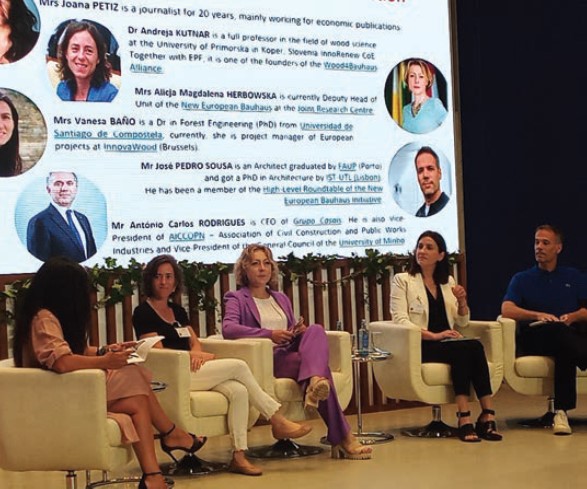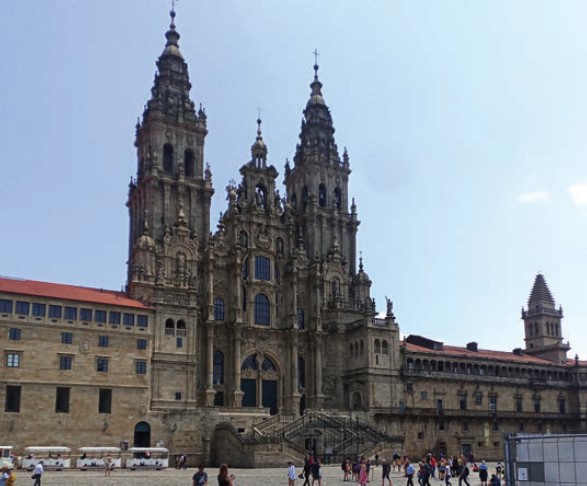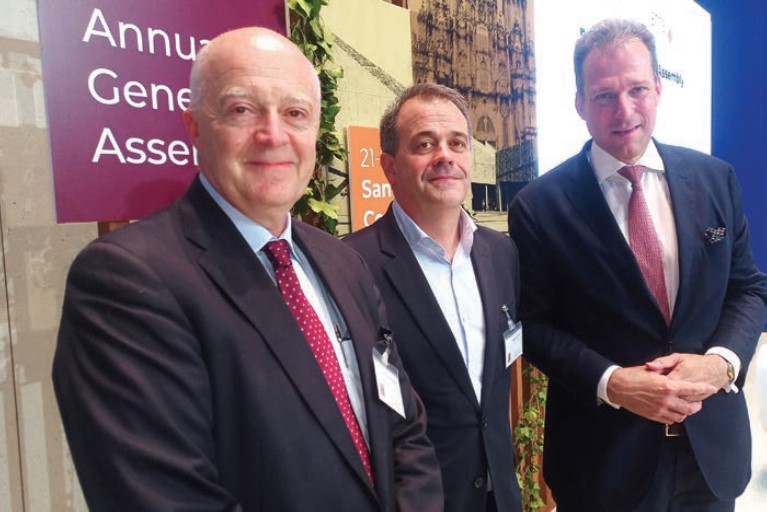European panels sector gathers
26 July 2023Representatives from wood-based panels producers from across the world descended on northern Spain for the annual European Panel Federation (EPF) AGM and conference on June 23
The atmospheric and ancient surroundings of Santiago de Compostela in northwest Spain was the setting for the annual European Panel Federation (EPF) AGM and conference this year.
EPF members, including panel producers from not just Europe but across the world, as well as machinery, chemicals and other providers gathered to hear the latest on panel product markets and how the EPF is lobbying on behalf of the sector. About 200 people were in attendance.
The event, which marked the release of the EPF Annual Report 2022-2023, was this year hosted by Iberian member association ANFTA.
EPF chairman Martin Brettenthaler, writing in his annual message in the Annual Report, said the difficult times the organisation had predicted ahead a year ago at the previous AGM in Ghent had been “partly right”.
“The energy prices went up quickly, but also receded in a rather fast and unexpected manner,” Mr Brettenthaler said.
“On the other hand, inflation remained a more persisting phenomenon.”
He said economists’ predictions of a quick rebound in business prospects had been inaccurate, with interest rate reductions “nowhere in sight” and China was not out of its economic challenges.
His core message to members was threefold: companies had to manage the economic turbulence; the sector needs to work together on all topics with common interest; and companies needed to challenge the burden of over regulations by governments and bureaucracies.
He called on legislators to make the shift to a more environmentally responsible world together with industry, not at the expense of it. Wood-based panel producers will still need wood, adhesives and energy, he said.
“Restrictions and regulation may be laid on forests, chemicals and energy, but they should not be so draconian that they shutter production.”
Mr Brettenthaler said he remained optimistic for the future of the wood-based panels industries, with consumers being increasingly informed in their choices, with a clear trend towards natural, climate positive products.
EPF STATISTICS
EPF statistics in the new Annual Report were given to members for the first time at the event. They reveal that European woodbased panel production reduced by 7.8% in 2022.
The output, relating specifically to EPF member countries, totalled 59.8 million m3. Consumption of wood-based panels followed a similar pattern, with a reduction of 7% (60.8 million m3) compared to 2021.
The latest stats follows the earlier release in May of provisional figures at the Interzum exhibition in Germany.
Clive Pinnington, EPF managing director, told delegates that essentially 2022 H1 had an “OK” performance, but H2 was “not quite a catastrophe, but nearly”, with the furniture industry in particular suffering in H2 with a 5% reverse.
European particleboard production reduced 6.9% in 2022 to 32.1 million m3.
The EPF said particleboard production capacity increased by 1% in 2022,with a 3.3% rise expected in 2023 and afterwards.
Germany remained the largest PB producer in Europe in 2022 with annual production of 5.5 million m3, down 8.9% compared to 2021.
Poland has confirmed its second position in the European PB production rankings with an output of 3.8 million m3 despite its numbers dropping by 9.6%. In third and fourth were France and Italy with a 3.15 million m3 and 2.74 million m3 output respectively, followed by Austria with 2.29 million m3.
The EPF said it was difficult to predict production output next year because of various geo-political pressures and economic headwinds.
But it expected the contraction in European PB production to slow down to 1.2% in 2023.
PB demand from the furniture and construction sectors still faced impact from the reduction in disposable incomes of households due to current uncertain economic developments.
In addition, PB trade was significantly reduced in 2022 with imports and exports decreasing by 5.5% and 7.4% respectively in the EU+UK+EFTA countries.
Most countries registered a decrease in their imports, except for Bulgaria (+59%), Latvia (+52%), Romania (+21%) and Spain (+11%).
Countries showing a decrease ranged from the -1.6% reverse in the Netherlands to -17% in Denmark.
Joint PB exports of the EPF member countries decreased by 7.4% to more than 10.6 million m3, with Germany (-12% to 1.9 million m3) being the largest exporter, then followed by neighbour Austria (-14% to 1.77 million m3).
Some 10% of all PB production was exported outside the EU-27 in 2022. After the exit of the UK from the EU, the UK has become the largest destination for European PB exports, with 612,000m3 (-8% compared to 2021), followed by China with more than 335,000m3.
EPF member countries’ apparent consumption decreased by 6.3% and amounted to more than 31.2 million m3. Germany, Poland, Italy, the UK and France remained the top five PB markets, with apparent consumption of 5.5 million m3, 3.9 million m3, 3.18 million m3, 2.7 million m3, and 2.7 million m3 respectively.
The EPF estimated European PB capacity at more than 39.4 million m3, up by 1.6% in 2022. Capacity additions came from extensions projects in Austria, Germany and Spain.
MDF & OSB
MDF suffered a more severe production output decline in 2022, with a 9.3% dip to 12.5 million m3, excluding producers in Turkey and Russia. It has to be noted that the comparison year (2021) had seen a sharp rise in output of 7.7%.
Germany remains by far the largest producer with a 3.8 million m3 production capacity in 2022, followed by Poland (2.91 million m3) and Spain (1.3 million m3).
In 2022, 44% of European MDF production consisted of panels over 9mm thickness; 27% was accounted for by 5-9mm thickness panels (up slightly); and thin MDF panels below 5mm was stable at 29%.
The trend towards MDF producers focusing on value-added products continues, with the split between raw and surfaced panels reaching 49% and 51% respectively.
EPF estimates that MDF consumption decreased by 3% to more than 11.6 million m3 in 2022, driven by the economic downturn.
German MDF consumption contracted by 4.9%, wiping out the gains experienced in 2021. The UK was the second largest consumer of MDF in Europe.
Extra-EU sales of MDF dropped by 27% compared to 2021, with the UK being the largest extra-EU destination for European MDF exports in 2022 (995,000m3).
EPF forecasts MDF production in EPF countries to decline by 1.9% in 2023 to 12.3 million m3, with consumption set to remain stable at 12 million m3 (-0.3%).
The OSB sector saw a 10.7% decline in production to 6.4 million m3, with Germany and Romania continuing to have the largest European OSB production capacities.
European (EU27+UK) apparent consumption of OSB contracted by 20% in the face of a drop of imports (-1.8%) and higher exports (+11%) in 2022. OSB consumption was estimated at nearly 5.15 million m3.
In 2023, EPF members expect the OSB production to rebound by 5.6%.
Meanwhile, softboard (predominantly woodfibre insulation board) suffered an 8.9% reverse to 5.1million m3.
European plywood production was down by 2.5% in 2022 to 3.1 million m3.
Consumption of wood-based panels in the key furniture industry declined by 1% in 2022. So, the furniture industry consumed 48% of all wood-based panels last year (down from 49% in 2021).
Elsewhere, at the EPF AGM, two roundtables were held focusing on the New European Bauhaus (NEB).
NEB is basically a creative and interdisciplinary initiative that connects the European Green Deal to living spaces and experiences. NEB calls for the imagining and building together of a sustainable and inclusive future.
Wood’s natural, ecological, low-carbon and aesthetic qualities place the material to potentially benefit from this movement, something that EPF has worked hard to promote.
Discussions centred on how wood-based panels can positively influence beauty, sustainability and togetherness in line with the NEB goals.
Panellists also debated NEB in everyday life, especially furniture and housing trends, with some key points on the impact of new ways of living and working.
Panellists included representatives from the European Furniture Industries Confederation, Wood4Bauhaus Alliance and the European Commission.


